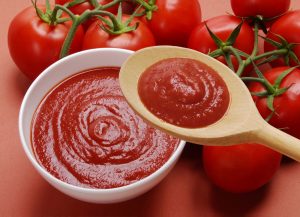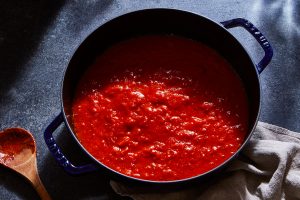Tomato sauce is a product that is produced from tomato paste and has been used in many cultures since the early stages of civilization but the art of making the best tomato sauce from a simple tomato paste lies in the recipes which every chef has acquired either through experience and experimenting with different material, quality and spices or inherited through their family members. But before going into details about how to make tomato sauce, we first need to know the main product that all these by-products like tomato sauce are made of.
- What are the advantages of these items?
- Tomatoes can help you avoid the harmful effects of smoking.
- Tomatoes are good for your heart.
- Properties of tomatoes for cell repair and muscle building
- Tomato paste
- Stages of the canned ketchup production line
- Quality control measures for tomato paste
- Tomato sauce
- Below are different methods for making different tomato sauces
Tomatoes: When it comes to tomatoes, you’re not sure whether they belong in the category of fruits or vegetables. It’s worth noting that tomatoes are a great source of nutrients and vitamins that everyone should take advantage of. Tomatoes are the most health-conscious and cooked food that comes from food without being processed, according to nutritionists because they prevent sickness and provide health information to all regions of the body.

What are the advantages of these items?
- Stimulating the body to convert glucose into useful energy for exercise
- Preventing blood clots, enhancing the immune system’s capacity to combat diseases like diabetes, and strengthening the nervous system and brain
- Tomatoes are full of antioxidants, that act as a powerful barrier against infectious diseases.
- Improve muscle circulation and sleep quality – Improve learning and memory power
- Tomatoes contain properties and health benefits that can help prevent cancer.
Tomatoes are a good source of Vitamin c and other antioxidants, which help to fight cancer-causing free radicals in our bodies. Polyphenols, a plant compound found in tomatoes, are effective in preventing prostate cancer. Tomatoes contain beta-carotene which has anti-cancer properties. According to Dr. John Erdman’s research, the compounds in tomatoes protect against gonorrhea which reduces the possibility of prostate cancer.

Tomatoes can help you avoid the harmful effects of smoking.
Lung cancer can be caused by smoking. Since tomatoes are strong in vitamin A, including them in your diet can help you avoid this fatal condition. Tobacco contains nitrosamines which are a serious carcinogen. The carcinogens’ detrimental effects are mitigated by the coumaric acid and chlorogenic acid found in tomatoes.
Tomatoes are good for your heart.
Tomatoes are high in fiber, choline, vitamin C, and potassium, all of which are beneficial to your heart. A major hurdle to preventing heart disease is stabilizing excessive potassium levels in relation to salt. Homocysteine levels in the blood are elevated due to the plant’s fiber content. Higher amounts of this chemical can increase your chances of having a heart attack or stroke. Tomatoes aid to lower harmful triglycerides and cholesterol levels in the body, protecting us from cardiovascular disease.
- Tomatoes can combat depression.
- Tomatoes can help you see better
- Tomatoes are gentle on the skin
- Improve the digestive system’s health with tomatoes
- Diabetic-friendly tomatoes
- Tomatoes to lower high blood pressure
- Tomatoes help prevent urinary tract infections
- Tomatoes help prevent gallstones
- Vitamins and minerals from the tomato powerhouse
- Tomatoes are helpful for weight loss
- Tomatoes Help Keep Bones Strong
- Tomatoes that Boost Your Immune System
- Benefits of tomatoes for hair
- Benefits of Eating Tomatoes During Pregnancy
- As a filling food
- Tomatoes that prevent free radicalsه

Properties of tomatoes for cell repair and muscle building
- Tomatoes prevent blood clots
- Tomatoes stabilize the body’s PH levels
- Tomatoes to help unclog pores
- Tomatoes to lighten the skin
- Tomatoes to prevent the signs of aging
- Tomatoes can serve as a sunscreen
- Tomatoes act as sedatives
- Tomatoes are natural bleach
- Tomatoes prevent sunburn
- Tomatoes are a remedy for the skin
- Tomatoes help fight hair loss
- Tomatoes kill dead skin cells
- hairdresser
- Tomatoes for dry hair
- Treatment of dandruff and inflammation of the scalp
- Storage
Tomato paste
Tomato paste is a concentrated tomato extract widely used in food as a condiment and to enhance its aroma, color, and flavor. Bright red, networked flavors and aromas are some of its visual characteristics. It has a Brix of around 28% and an acidity of 4.3. Add 2-3% salt and it works in large quantities. And the table set on the market.
The package type is usually two and a half kilograms. The tomato paste must be homogeneous, free from mold, free from unwanted particles, free from chemical preservatives, and good in color and flavor.
Ingredients: Tomatoes suitable for the preparation of pasta must be large, thin skin, soft texture, high solids content (Brix), red skin, pleasant flavor and aroma, healthy without mold, insects, water holes without large alkalis Raw, rich in monosaccharides and disaccharides with low acidity, resistant to mold formation, they must be ripe at the time of harvest, but not too much. Small containers are best for transporting tomatoes to keep them from cracking and cracking.

Stages of the canned ketchup production line
- Wash: A washing operation is performed to separate and remove the mud particles from the soil for this the product is immersed in water for 4-6 minutes, during this operation compressed air is introduced into the container. Tomatoes and suspensions are cleaned effectively. After this phase, the product is washed with the curtains which have been pumped at high pressure with clean water that circulates on the path of the next phase to decontaminate the sink in large quantities.
- Inspection on the belts (sorting): At this point, the tomatoes are forcibly lifted by a special conveyor belt, which takes the tomatoes through an examination area where the tomatoes on the conveyor belt passing through will be examined by humans for any contaminants, fungi, insects, children, plant debris and other contaminants.
- Crushing and shredding (pulp): At this point, the healthy and processed tomatoes are automatically transferred to a device called the Pulper. The device has two toothed teeth, one fixed and one movable, through which the tomato is compressed, cut, crushed and transformed into tomato concentrate.
- Skin removal (filtration): To separate the base from the housing and eliminate any impurities, two or three-stage filters are used, cylindrical in shape with 1.2-1.6 mm diameter holes, sometimes 2 mm for the first step, 0.6-0, 8 mm. The second pass is 0.3-0.4mm and the third pass o (Finisher) separates the large, medium and small particles respectively.
- thickening using a vacuum system: A vacuum evaporator is used to remove excess water. The use of a vacuum system allows the excess water to evaporate more quickly and the components to be kept at low temperatures for a short period of time, in order to preserve the color and other aesthetic characteristics of the product well. This stage is carried out in a double-walled boiler heated by steam pressure with a capacity of approximately 2.5-5 tons.
- Filling, venting, marking, and canning: Cans are usually made of metal with a painted interior. They are available in capacities of half a kilo and one kilogram. The jars are automatically cut before being filled with steam, then the transfer of part of the filling to the filling is carried out directly by the extractor, and the venting phase takes place by inserting steam to eliminate the air between the products and create a relative vacuum. . to complete.
- The heating process: This step is done in a pot of hot water. In this way the cans are transferred to the hot water boiler immediately after passing through the conveyor belt, and undergo a process of heating the hot water to 100 ° C for 80-45 minutes, depending on the type of can. After removing the jar from the pot, cool it by sprinkling cold water over the jar.

Quality control measures for tomato paste
- A) Physical measurement of the tomato paste
1- Test for the determination of soluble solids in water (BRICS)
Set the Brix for domestic use (regardless of the salt) to at least 25%. Due to the addition of 2-3% of salt to the solution. The final Brix was 28% – 27%.
Brix measurements are performed using manual or benchtop refractometers.
2- Measure the dirt (tiles)
The ketchup must be uniform, free from impurities and dark particles, without nuts, without shells, without fibers, without essence and the right amount of impurities should be poured on a soft white tile and flattened with a clear glass plate. A thin layer of product is formed between two surfaces and unwanted particles such as grains, shells, plant residues and carbonized particles and their quantity and type can be identified and clearly seen.
- B) Chemical tests of ketchup
1- PH Test
The normal pH of tomato paste is around 4.3, measured by other methods of measuring PH.
2- Willard salt test
Bring 2.5 g of sample to 100 ml, remove 10 ccs, add 1.5-5 ml of potassium chromate reagent and titration solution, and 0.1 silver nitrate until brick red.
Multiply your silver nitrate consumption by / 585. The resulting number should be between 3-2.
How to make a simple 1/0 silver nitrate
cc 500 distilled water × 5/8 gr silver nitrate
cc 1000 distilled water × 17 gr silver nitrate
How to prepare the potassium chromium reagent in ketchup
Bring 50 g of dried potassium chromate in a volume of 100 ccs.
- C) Measurement of the tomato microbiota
1- Two serum agar presses (O.S.A) and (Y.G.C) were used to identify bacteria and fungi in the product.
2- Haward Method Pie Counting Test
In this way, pour the tomato paste into the special 25-room slides and use the telescope to count the number of mold carcasses in each room, and the average should be 40.

Tomato sauce
The sauce is one of the most popular food ingredients in the world and has many fans. These are the components of the taste and flavor of food. There are famous sauces from France, the French use different spices in many of their dishes, and one of the most popular ingredients in France is tomato sauce. One of the most popular sauces in the world is tomato and, as the name suggests, the main ingredient is tomato. Tomato paste or red sauce is usually made from chopped ripe tomatoes and today the main ingredients of tomato paste are tomatoes, vinegar, sugar, salt, pepper and cinnamon.
- Different types of tomato sauce: Mexican tomato sauce, Italian tomato sauce, French Tomato Sauce, Indian tomato sauce or Chutney
Below are different methods for making different tomato sauces
- Mexican tomato sauce or Salsa
Recipe: First, remove the top and bottom of the tomatoes with a fork, then cook over high heat for five to six minutes. If you don’t have a grill or roast at home, use an oven over high heat and peel the tomatoes after they have cooled. You can roast tomatoes or even eat them raw. To peel raw tomatoes, simply place the tomatoes in a bowl of boiling water and peel them easily. But roasted tomatoes give your salsa a smoky flavor and are probably the best option. Put the tomatoes in a blender (blender or food processor), add the other ingredients and blend together. Be careful not to break the toppings too much, as the sauce knows the toppings are just under your teeth. Pour the sauce into a bowl, cover with cellophane and refrigerate it for an hour or two, it will taste even better. The sauce is ready and you can enjoy it.
- Italian Marinara sauce
Recipe: First, grate the onion and fry it lightly in olive oil (until it changes color). Add the mushrooms and stir often to remove the mushroom juices from the center. Then pour the mushroom, onion and vegetable mixture into the mixture and toss to coat. Bring the tomato puree to a boil over the heat then add the mixture and continue to cook over low heat until tender. Measure the salt and pepper and stir occasionally to prevent them from settling. When the sauce has thickened, turn off the heat and let it cool.
- French classic tomato sauce
Recipe: 1- Heat the oil on the stove. Fry the onion until slightly soft. Then add the onions, carrots, and celery. Cook until soft and golden, about 5 minutes.
- Add the tomatoes and tomato juice, lightly fry until soft, then return to the water. Then add the sauce along with the vegetables. To boil. Cover and simmer for about 2 hours. You can also use a slow cooker. Stir often to avoid burns.
- After this time, remove from heat and remove the vegetables. Let it cool down a bit. Then use an electric meat grinder to whisk until smooth and smooth. Season with salt and pepper.
- Indian tomato sauce or Chutney
Recipe:

- Pour the liquid oil into the pan and put it over the heater.
- Then pour the cashews and green beans into the oil and sauté lightly.
- Once the ingredients have slightly changed color, turn off the heat and let it cool.
- Pour the ingredients into another pan.
- Turn the heat on again and wait until they are hot.
- Then add the red peppers to the oil and sauté a little.
- Add the chopped onion and tomatoes.
- Then add the garlic and ginger along with the salt and turmeric to the pot.
- Cook all the ingredients over low heat until they change color.
- Now grind the fried cashews and the cumin.
- Put the tomato and onion ingredients in a blender until completely smooth.
- Now you can add the ground cashews.
- If you want to garnish your food, fry the mustard seeds along with the cumin seeds and curry leaves, then pour the chutney over them.










Your comment submitted.